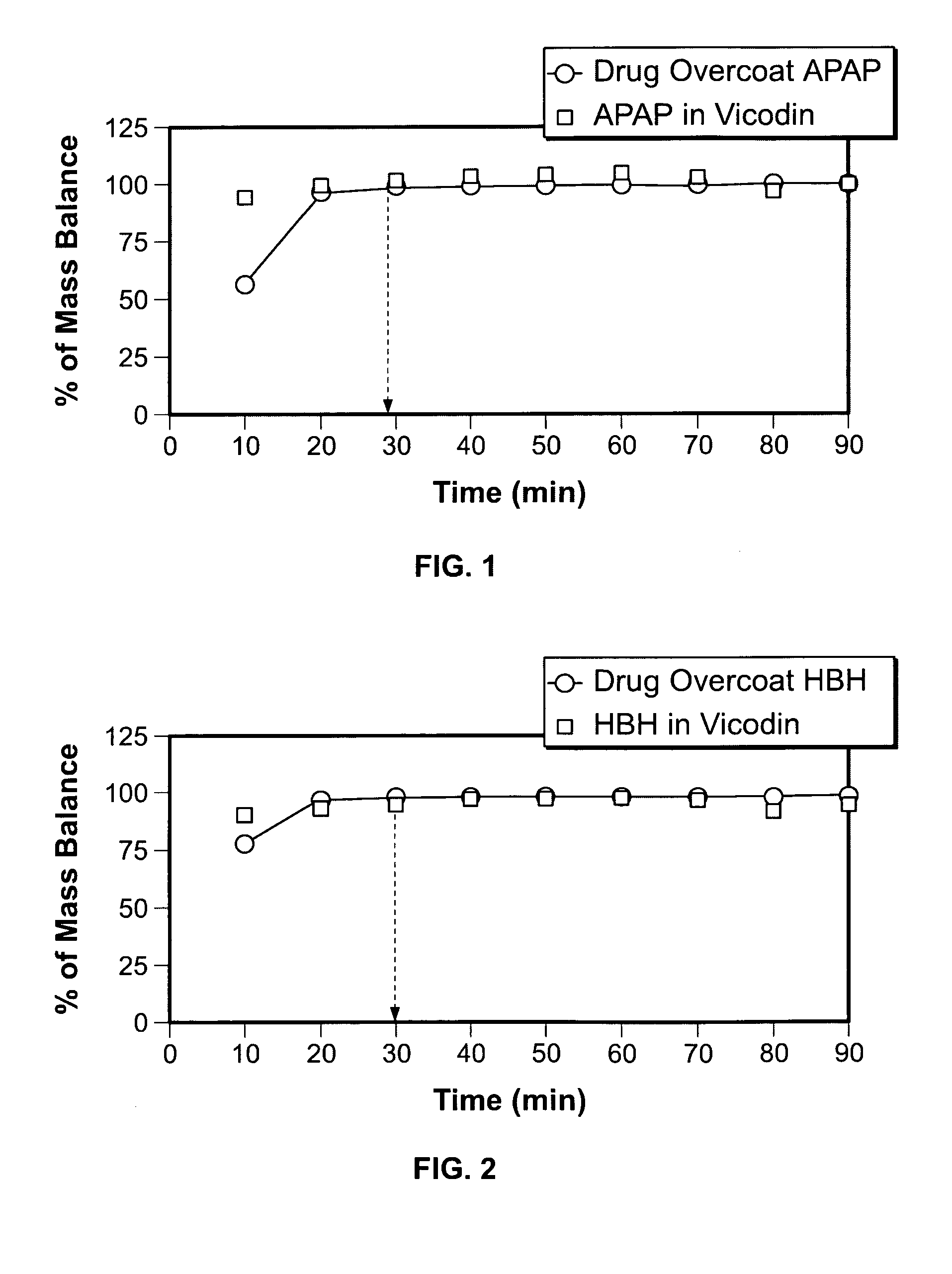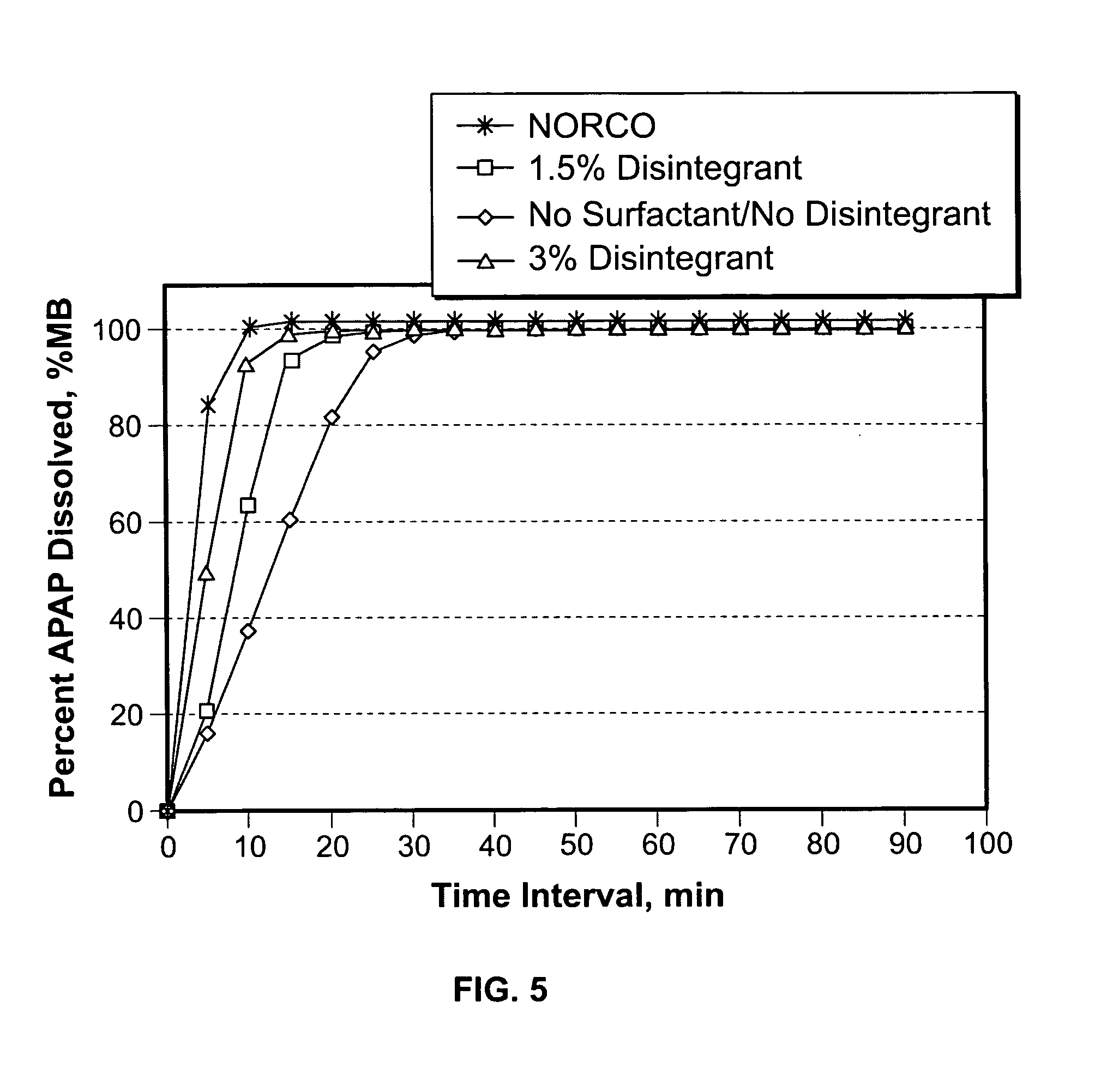Drug coating providing high drug loading and methods for providing same
a coating and drug technology, applied in the direction of osmotic delivery, drug composition, biocide, etc., can solve the problems of increasing the thickness of the coating required to deliver the desired dose of drugs, affecting the safety of patients, so as to facilitate production and facilitate the effect of drug distribution, increase the viscosity of the coating composition, and uniform distribution
- Summary
- Abstract
- Description
- Claims
- Application Information
AI Technical Summary
Benefits of technology
Problems solved by technology
Method used
Image
Examples
example 1
[0047] A drug coating according to the present invention was provided over placebo dosage forms. The coating included 7.2 wt % film-forming agent formed of a blend of HPMC E5 (supplied by Dow) and copovidone (Kollidon® VA 64, supplied by BASF). The HPMC accounted for 4.3 wt % of the drug coating, and the Kollidon® VA 64 accounted for 2.9 wt % of the drug coating. Ibuprofen USP was the drug included in the drug coating, and the ibuprofen USP accounted for 92.8 wt % of the drug coating.
[0048] In order to form the drug coating, an aqueous coating formulation was created using purified water USP as the solvent. The coating formulation included a solids content of 24 wt % and a solvent content of 76 wt %. The solids loaded into the coating formulation were those that formed the finished drug coating, and the solids were loaded in the coating formulation in the same relative proportions as contained in the finished drug coating. The coating formulation was mixed using standard procedures...
example 2
[0050] A drug coating according to the present invention was provided over placebo dosage forms. The coating included 17.8 wt % film-forming agent formed of a blend of HPMC E5 (supplied by Dow) and copovidone (Kollidon® VA 64, supplied by BASF). The HPMC accounted for 10.7 wt % of the drug coating and the Kollidon® VA 64 accounted for 7.1 wt % of the drug coating. The drug included in the coating was ibuprofen USP, and the ibuprofen USP accounted for 82.2 wt % of the drug coating.
[0051] In order to form the drug coating, an aqueous coating formulation was created using purified water USP as the solvent. The coating formulation included a solids content of 20 wt % and a solvent content of 80 wt %. The solids loaded into the coating formulation were those that formed the finished drug coating, and the solids were loaded in the coating formulation in the same relative proportions as contained in the finished drug coating. The coating formulation was mixed using standard procedures to ...
example 3
[0053] A drug coating according to the present invention was provided over placebo dosage forms. The coating included 6.0 wt % film-forming agent formed of a blend of HPMC E5 (supplied by Dow) and copovidone (Kollidon® VA 64, supplied by BASF). The HPMC accounted for 3.6 wt % of the drug coating and the Kollidon® VA 64 accounts for 2.4 wt % of the drug coating. The drug coating also included HPC (Klucel® MF) as a viscosity enhancer. The HPC accounted for 1.5 wt % of the drug coating. The drug included in the drug coating was acetaminophen USP (APAP USP, supplied by BASF as a fine powder), and the APAP USP accounted for 92.5 wt % of the drug coating.
[0054] In order to form the drug coating, an aqueous coating formulation was prepared using purified water USP as the solvent. The coating formulation included a solids content of 20 wt % and a solvent content of 80 wt %. The solids loaded into the coating formulation were those that formed the finished drug coating, and the solids were ...
PUM
| Property | Measurement | Unit |
|---|---|---|
| solubility | aaaaa | aaaaa |
| solubility | aaaaa | aaaaa |
| solubility | aaaaa | aaaaa |
Abstract
Description
Claims
Application Information
 Login to View More
Login to View More - R&D
- Intellectual Property
- Life Sciences
- Materials
- Tech Scout
- Unparalleled Data Quality
- Higher Quality Content
- 60% Fewer Hallucinations
Browse by: Latest US Patents, China's latest patents, Technical Efficacy Thesaurus, Application Domain, Technology Topic, Popular Technical Reports.
© 2025 PatSnap. All rights reserved.Legal|Privacy policy|Modern Slavery Act Transparency Statement|Sitemap|About US| Contact US: help@patsnap.com



